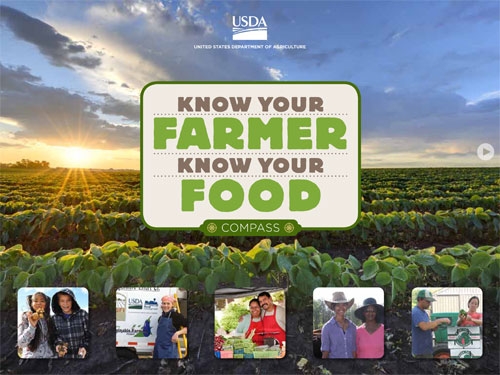Know your farmer, know your food
The 2008 Farm Bill provided more support for local and regional agriculture. In 2009, under the leadership of deputy secretary Kathleen Merrigan, the USDA launched its Know Your Farmer, Know Your Food initiative, with an eye towards doing just that. The list of initiative goals is lengthy, but include promoting, locally and regionally produced and processed foods; expanding access to affordable and fresh food; and demonstrating the explicit connections between food, agriculture, communities and the environment.
Know Your Farmer, Know Your Food is a USDA-wide effort. It is not a new department, but rather, an effort that seeks to more effectively connect existing USDA departments and work to strengthen local and regional food systems.
We know that demand for local and regional foods is strong. Per USDA statistics, the number of farmers markets has more than tripled in the past 15 years and there are now more than 7,175 around the country. The community supported agriculture (CSA) model has grown from 2 operations in 1986 to more than 4,000 today. Farm-to-school programs have experienced explosive growth, and are now found in 48 states, and total more than 2,200 (per the USDA, there were two such programs in 1996). There are “branding” efforts touting what is produced “locally” (or regionally, or statewide) in each of the 50 states.
These efforts are important: local and regional food efforts are vital to local economies, as they can often provide farmers with a higher share of the food dollar. Local jobs are supported and created in this manner, as money spent at a local business often continues to circulate within the community, creating a multiplier effect. Food dollars are good dollars.
On February 29, 2012, the USDA’s Know Your Farmer, Know Your Food initiative launched its new Know Your Farmer (KYF) Compass. The KYF Compass is a digital guide to USDA resources related to local and regional food systems. The KYF Compass organizes the USDA's work on local and regional food systems into seven thematic areas. The Compass provides tools for navigating to learn more about local and regional food systems and projects. The site enables users to secure the most up-to-date information and create interactive scenarios on a variety of topics relating to local and regional food systems, including:
- What local and regional food systems are
- Infrastructure
- Farm-to-Institution (including Farm-to-School)
- Stewardship and local food
- Local meat and poultry
- Healthy food access
- Careers in agriculture and food systems
- Case studies
- Interactive mapping tools that enable site users to locate USDA-funded local and regional food systems projects in their area (note to researchers: score!)
One of my interests is food access. The site did not fail to satisfy me in this respect. The food environment atlas tool enabled me to construct a spatial overview of the ability of specific communities to access healthy and fresh foods. In very short order, I was able to construct a rough demographic overview of how my county measured up in terms of residents’ access to grocery stores, the prevalence (and growth) of fast food restaurants, etc. This information could then be compared against other communities (or in my case, adjacent counties). This tool, along with other USDA food access tools, will prove invaluable to site users (including social science researchers). The USDA’s Economic Research Service produces some of the most cutting-edge and valuable research in this area; the site makes this information even more accessible.
The site also provides ways consumers can more directly connect with producers, a key part of building and sustaining local and regional food economies.
The Compass explicitly links food and agriculture, and shows just how interconnected the food system is with the economy, the health of communities, and the larger environment.
President Obama recently said, “Local food systems work for America: when we create opportunities for farmers and ranchers, our entire nation reaps the benefit.” The Know Your Farmer, Know Your Food initiative continues to grow, to improve and to support this vital sector of our nation’s food system.


